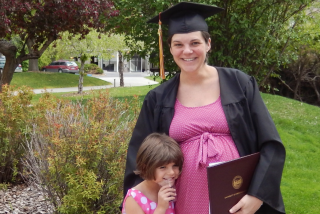Book Review: ‘The Red Thread: A Novel’ by Ann Hood
The Red Thread
A Novel
Ann Hood
W. W. Norton: 304 pp., $23.95
Destiny is tricky in fiction. In real life, destiny’s best quality is clarity — the cleared path, the right decision, the way things are. So I’m told. But in fiction, destiny can seem forced, Hallmarky. The omniscient narrator looks forward and backward, weaving a clumsy pattern among seemingly disparate people and events. The trouble is, the omniscient narrator is only a false god, only an author. The real God has had a lot more practice moving pieces around the board. The real God is far more graceful, more subtle. So I’m told.
Ann Hood finds a way to negotiate this dilemma. Her main character, Maya Lange, believes in destiny. She runs an adoption agency in Providence, R.I., called the Red Thread. The name comes, she explains to her clients who come to her hoping to adopt babies from China, from the Chinese belief that people who are destined to be together are linked by an invisible thread. Maya has placed more than 450 Chinese babies — all girls — with families; in many cases, she has seen a kind of magic at work in the pairing, a magic that works in spite of bureaucracies, the cruel realities of life in China and the nervous passion of the parents who desperately want a baby.
Maya’s unshakable faith in the process is fueled by pain. She was responsible for the death of her own baby daughter years before the novel opens. She was drying the baby after a bath; she had many things on her mind. She accidentally dropped the little girl, whose head hit the bathtub. In her desperation, Maya left her husband. She found a new life; started the Red Thread.
Hood’s characters are connected: The hopeful families who begin the process one September and the mothers in China who are forced — by family, culture and government — to give their babies up. Each couple embodies a different vulnerability when it comes to adoption: the fear that you will lose the attention of your partner; the fear that the baby will carry a genetic disorder; the fear that one’s partner will value a previous child, a prior family more than this one; the myriad imbalances that occur when two people are expected to want the same thing at the same time. Each character glitters from several vantage points — from inside his or her own mind, through Maya’s experienced eyes and through the eyes of the omniscient narrator. All these perspectives help flesh these people out, which is especially important in a novel in which the characters are seen through the lens of a very specific point in their lives. Seeing the control freak, Nell, for example, from several angles helps soften her — she becomes more than a cartoon character with a big problem; more than the sum of her parts.
The mothers in China have more terrifying problems, it is true. Some find a way to say no when they are expected to give up their precious girls but most do not. Ni Fan, Chen Chen, Li Guan and the others suffer deeply at the hands of a ruthless policy. Their stories are difficult to read and make a mockery of destiny, until they are attached, by one of Maya’s threads, to a family who wants and needs them.
But there is another way that Hood surmounts the tawdriness of destiny. She understands Maya’s suffering. Empathy, even between an author and her character, is a conduit to grace. Hood and her husband lost their daughter Grace to a strep infection in 2002, when she was 5. Three years after her death, they adopted Annabelle from Changsha in China’s Hunan province.
A reader who knows this about Hood might struggle with the impulse to allow her to write a story that is not autobiographical, but Maya’s suffering drives the story forward; it is the force that binds all of the characters together, in China and in Providence. And its vividness has a base in reality. In her acknowledgements, Hood details their adoption; the agency they used, the woman who runs it and the families they got to know in the process.
Toward the end of “The Red Thread,” after Maya has decided to adopt a baby that will not be coming home with one of the couples in her group, she goes into her attic to look, for the first time in years, through a box of her daughter’s things. “How does a mother choose what to keep to best remember her dead child? The little leopard booties that she never even wore but that Maya had bought her for her two-month birthday? The cotton blanket that smelled slightly of spit-up, so ordinary in its appearance and usefulness?” This scene and these details have an undeniable heat — their provenance lies in Hood’s own experience. Her pain is the red thread between fact and fiction, it sets the fiction on fire, it animates like God.
Terrible, but true. That pain allows the author to write about destiny without the tinny sound it so often has in fiction. She has seen the threads at work. She knows what she is talking about.
Salter Reynolds is a writer in Los Angeles.
More to Read
The biggest entertainment stories
Get our big stories about Hollywood, film, television, music, arts, culture and more right in your inbox as soon as they publish.
You may occasionally receive promotional content from the Los Angeles Times.






